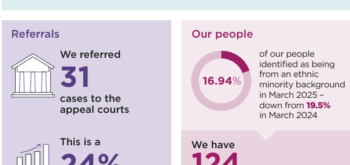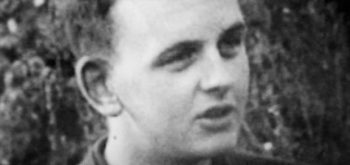 In my line of work as a personal injury lawyer specialising in complex cases I often represent PTSD sufferers. Whilst I cannot begin to imagine how it must feel to live with the condition, I witness how crippling it can be – not only to a person’s well-being and quality of life but also to the loved ones around them. Pic by Dr Gray from Flickr under creative comms licence
In my line of work as a personal injury lawyer specialising in complex cases I often represent PTSD sufferers. Whilst I cannot begin to imagine how it must feel to live with the condition, I witness how crippling it can be – not only to a person’s well-being and quality of life but also to the loved ones around them. Pic by Dr Gray from Flickr under creative comms licence
- Louisa Chambers is a solicitor and chartered legal Executive in Spencers Solicitors catastrophic injury team
Matthew Kaye passed away last year. He’d accidentally taken an overdose. He had been diagnosed with PTSD after being crushed against a fence during the Hillsborough tragedy in 1989, aged seven.
Post-Traumatic Stress Disorder (PTSD) is commonly known to affect retired or active military servicemen and servicewomen. But any one of us could be diagnosed with the anxiety syndrome during our lifetime – and some of us could be unknowingly living with the condition today.
A PTSD tragedy
As revealed by the Daily Record, Mr Kaye never recovered from Hillsborough and turned to hard drugs as a young adult. The toxicologist determined that his death was caused by ‘heroine misuse’, during the early hours of April 6th 2013.
Mr Kaye’s mother explained how her son ‘struggled to fit in at college or work’. His friend who was with him at the time of death, told the inquest that Hillsborough ‘really affected him’, that ‘he wouldn’t let anyone touch him’ and that he ‘used the substances to deal with his anxiety’.
This is a clear example of somebody who has gone on to suffer the worst kind of PTSD, due to an incident outside of the military.
Mr Kaye was diagnosed, but there were tens of thousands of football fans there that day who may have also been affected, yet are oblivious to their potential condition (not to mention the police, match officials, shopkeepers and many more people in and around the ground on the date of the disaster).
Furthermore, those who watched the drama unfold on television may also be suffering from some form of PTSD.
The National Institute of Mental Health (NIMH) states that the disorder can be triggered just by seeing a dangerous event. ‘Some people get PTSD after a friend or family member experiences danger or is harmed. The sudden, unexpected death of a loved one can also cause PTSD,’ it says.
Simply from an awareness perspective, it is crucial for everybody to understand that a person does not need to survive live danger, to become seriously affected by what is effectively shell-shock.
However, as far as the law is concerned, you do have to experience the live event, in order to qualify for any sort of redress. And so anybody viewing the Hillsborough disaster on TV is unable to claim for PTSD compensation – even if their loved ones were onscreen.
So by that same token, if you watched your child being crushed to death on television, in the eyes of the law, if you developed PTSD as a result of what you witnessed on screen, you would not be entitled to any justice because you were not there, or actively involved in the immediate aftermath.
The law on PTSD explained
When I say ‘the law’, I am referring specifically to the case of Alcock v Chief Constable of South Yorkshire Police [1992] 1 AC 310.
John Spencer delivered the best explanation of the law (otherwise near indecipherable to the layman) HERE.
‘Alcock and several other claimants were what the law describes as ‘secondary victims’: they were not primarily affected, in the sense that they were injured or in danger of injury, but they suffered harm because of what they witnessed. The Alcock case, which went all the way to the House of Lords Judicial Committee, imposed a series of ‘control mechanisms’ to fetter a victim’s ability to bring a claim. If these ‘control mechanisms’ are not met, there is no duty of care, and therefore no possibility of a claim for negligence. Chief among them is the requirement that a claimant must perceive a ‘shocking event’ with his or her own senses, either as an eye-witness or happening upon its immediate aftermath.’
The purpose of a sufferer’s claim would be to gain justice for a condition inflicted upon them through no fault of their own. Just because that condition was inflicted through the medium of television; or another third party the House of Lords is basically saying ‘it doesn’t count’ – a stark contrast to the medical facts as set out by the NIHM.
I have acted for a father who attended the immediate aftermath of a road traffic accident in which his 18 year old son tragically died. Not only did he witness the upturned car and the police clear up operation, he was required on the same day to formally identify his son. He was in the eyes of the law classed as a ‘primary victim’.
As a consequence of what he witnessed that day my client developed a major depressive disorder and PTSD. The symptoms were crippling, he was unable to work and sadly separated from his wife.
Fortunately for this client he was able to achieve some justice and we recovered compensation for him, but had he been told of his son’s death say over the telephone, and developed the same conditions he may not have been able to recover compensation.
It’s about time for change
John Spencer echoed Lord Steyn of Mostyn’s opinion on the law for the recovery for psychiatric harm as ‘a patchwork quilt of distinctions which are difficult to justify’. And it’s difficult for anybody to disagree.
Parliament can vote for a change in the law (ideally a removal of the ‘control mechanisms’) but only time will tell if such a change will come.
The current rules were put in place during a time of high political agenda and when the court deemed it necessary to control the number of cases being brought for psychiatric harm. The rules though have proved to lead to injustice. Recently following years of campaigning an inquest has been opened into the cause of the Hillsborough disaster in 1989; perhaps now is also the time for a review of the law limiting justice for victims of psychiatric harm following such events.
In the meantime, it’s a case of raising awareness – not just about the seemingly flawed legalities surrounding PTSD claims, but also about the condition itself and how you do not have to be a disaster survivor, in order to suffer what could be life threatening symptoms. Mr Kaye’s life wasn’t taken immediately but his suffering ultimately and, in my opinion, undeniably led to his tragic death.
- If you’re wondering whether you are suffering from PTSD, you consult the NIMH. Alternatively, you can visit the very accurate (and honest) guidelines created by the Hillsborough Justice Campaign here.






